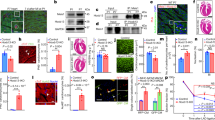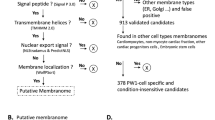Abstract
Heart disease is a leading cause of death in newborn children and in adults. Efforts to promote cardiac repair through the use of stem cells hold promise but typically involve isolation and introduction of progenitor cells. Here, we show that the G-actin sequestering peptide thymosin β4 promotes myocardial and endothelial cell migration in the embryonic heart and retains this property in postnatal cardiomyocytes. Survival of embryonic and postnatal cardiomyocytes in culture was also enhanced by thymosin β4. We found that thymosin β4 formed a functional complex with PINCH and integrin-linked kinase (ILK), resulting in activation of the survival kinase Akt (also known as protein kinase B). After coronary artery ligation in mice, thymosin β4 treatment resulted in upregulation of ILK and Akt activity in the heart, enhanced early myocyte survival and improved cardiac function. These findings suggest that thymosin β4 promotes cardiomyocyte migration, survival and repair and the pathway it regulates may be a new therapeutic target in the setting of acute myocardial damage.
This is a preview of subscription content, access via your institution
Access options
Subscribe to this journal
Receive 51 print issues and online access
$199.00 per year
only $3.90 per issue
Buy this article
- Purchase on Springer Link
- Instant access to full article PDF
Prices may be subject to local taxes which are calculated during checkout





Similar content being viewed by others
References
American Heart Association, Heart Disease and Stroke Statistics—2004 update 11–14 (American Heart Association, Dallas, Texas, 2004)
Hoffman, J. I. E. & Kaplan, S. The incidence of congenital heart disease. J. Am. Coll. Cardiol. 39, 1890–1900 (2002)
Orlic, D. et al. Bone marrow cells regenerate infarcted myocardium. Nature 410, 701–705 (2001)
Beltrami, A. P. et al. Adult cardiac stem cells are multipotent and support myocardial regeneration. Cell 114, 763–776 (2003)
Anversa, P. & Nadal-Ginard, B. Myocyte renewal and ventricular remodelling. Nature 415, 240–243 (2002)
Balsam, L. B. et al. Haematopoietic stem cells adopt mature haematopoietic fates in ischaemic myocardium. Nature 428, 668–673 (2004)
Murry, C. E. et al. Haematopoietic stem cells do not transdifferentiate into cardiac myocytes in myocardial infarcts. Nature 428, 664–668 (2004)
Srivastava, D. & Olson, E. N. A genetic blueprint for cardiac development: Implications for human heart disease. Nature 407, 221–226 (2000)
Safer, D., Elzinga, M. & Nachmias, V. T. Thymosin β4 and Fx, an actin-sequestering peptide, are indistinguishable. J. Biol. Chem. 266, 4029–4032 (1991)
Huff, T., Muller, C. S., Otto, A. M., Netzker, R. & Hannappel, E. Beta-Thymosins, small acidic peptides with multiple functions. Int. J. Biochem. Cell Biol. 33, 205–220 (2001)
Sun, H. Q., Kwiatkowska, K. & Yin, H. L. β-Thymosins are not simple actin monomer buffering proteins. Insights from overexpression studies. J. Biol. Chem. 271, 9223–9230 (1996)
Hertzog, M. et al. The β-thymosin/WH2 domain; structural basis for the switch from inhibition to promotion of actin assembly. Cell 117, 611–623 (2004)
Marinissen, M. J. et al. Small GTP-binding protein RhoA regulates c-jun by a ROCK-JNK signaling axis. Mol. Cell 14, 29–41 (2004)
Olave, I. A., Reck-Peterson, S. L. & Crabtree, G. R. Nuclear actin and actin-related protein in chromatin remodeling. Annu. Rev. Biochem. 71, 755–781 (2002)
Malinda, K. M. et al. Thymosin β4 accelerates wound healing. J. Invest. Dermatol. 113, 364–368 (1999)
Sosne, G. et al. Thymosin β4 promotes corneal wound healing and decreases inflammation in vivo following alkali injury. Exp. Eye Res. 74, 293–299 (2002)
Grant, D. S. et al. Thymosin β4 enhances endothelial cell differentiation and angiogenesis. Angiogenesis 3, 125–135 (1999)
Fukuda, T., Chen, K., Shi, X. & Wu, C. PINCH-1 is an obligate partner of integrin-linked kinase (ILK) functioning in cell shape modulation, motility, and survival. J. Biol. Chem. 278, 51324–51333 (2003)
Troussard, A. A. et al. Conditional knock-out of integrin-linked kinase demonstrates an essential role in protein kinase B/Akt activation. J. Biol. Chem. 278, 22374–22378 (2003)
Lin, S. C. & Morrison-Bogorad, M. Developmental expression of mRNAs encoding TB4 and TB10 in rat brain and other tissues. J. Mol. Neurosci. 2, 35–44 (1990)
Gomez-Marquez, J., Franco del Amo, F., Carpintero, P. & Anadon, R. High levels of mouse thymosin β4 mRNA in differentiating P19 embryonic cells and during development of cardiovascular tissues. Biochim. Biophys. Acta 1306, 187–193 (1996)
Van den Hoff, M. J. et al. Myocardialization of the cardiac outflow tract. Dev. Biol. 212, 477–490 (1999)
Kelly, R. G. & Buckingham, M. E. The anterior heart-forming field: voyage to the arterial pole of the heart. Trends Genet. 18, 210–216 (2002)
Frohm, M. et al. Biochemical and antibacterial analysis of human wound and blister fluid. Eur. J. Biochem. 237, 86–92 (1996)
Huang, W. Q. & Wang, Q. R. Bone marrow endothelial cells secrete thymosin β4 and AcSDKP. Exp. Hematol. 29, 12–18 (2001)
Runyan, R. B. & Markwald, R. R. Invasion of mesenchyme into three-dimensional collagen gels: a regional and temporal analysis of interaction in embryonic heart tissue. Dev. Biol. 95, 108–114 (1983)
Zhang, Y. et al. Assembly of the PINCH-ILK-CH-ILKBP complex precedes and is essential for localization of each component to cell-matrix adhesion sites. J. Cell Sci. 115, 4777–4786 (2002)
Brazil, D. P., Park, J. & Hemmings, B. A. PKB binding proteins. Getting in on the Akt. Cell 111, 293–303 (2002)
Arai, A., Spencer, J. A. & Olson, E. N. STARS, a striated muscle activator of Rho signaling and serum response factor-dependent transcription. J. Biol. Chem. 277, 24453–24459 (2002)
Delcommenne, M. et al. Phosphoinositide-3-OH kinase-dependent regulation of glycogen synthase kinase 3 and protein kinase B/AKT by the integrin-linked kinase. Proc. Natl Acad. Sci. USA 95, 11211–11216 (1998)
Mangi, A. A. et al. Mesenchymal stem cells modified with Akt prevent remodeling and restore performance of infarcted hearts. Nature Med. 9, 1195–1201 (2003)
Philp, D. et al. Thymosin β4 and a synthetic peptide containing its actin-binding domain promote dermal wound repair in db/db diabetic mice and in aged mice. Wound Rep. Reg. 11, 19–24 (2003)
Depre, C. et al. Program of cell survival underlying human and experimental hibernating myocardium. Circ Res. 95, 433–440 (2004)
Yamagishi, H. et al. Tbx1 is regulated by tissue-specific forkhead proteins through a common sonic hedgehog-responsive enhancer. Genes Dev. 17, 269–281 (2003)
Yu, F. X., Lin, S. C., Morrison-Bogorad, M., Atkinson, M. A. & Yin, H. L. Thymosin beta 10 and thymosin beta 4 are both actin monomer sequestering proteins. J. Biol. Chem. 268, 502–509 (1993)
Garg, V. et al. GATA4 mutations cause human congenital heart defects and reveal an interaction with TBX5. Nature 424, 443–447 (2003)
Garner, L. B. et al. Macrophage migration inhibitory factor is a cardiac-derived myocardial depressant factor. Am. J. Physiol. Heart Circ. Physiol. 285, 500–509 (2003)
Mora, C. A., Baumann, C. A., Paino, J. E., Goldstein, A. L. & Badamchian, M. Biodistribution of synthetic thymosin β4 in the serum, urine, and major organs of mice. Int. J. Immunopharmacol. 19, 1–8 (1997)
Acknowledgements
The authors wish to thank A. L. Goldstein for his advice and RegeneRx Biopharmaceuticals Inc. for providing the synthetic thymosin β4 protein; J. Richardson and the histopathology core for histological support; G. A. Adams for technical asssistance; E. N. Olson and members of the Srivastava laboratory for discussions and critical review; and S. Johnson and J. E. Marquette for graphical help and suggestions. D.S. was supported by grants from the NHLBI/NIH, March of Dimes Birth Defects Foundation, American Heart Association and Donald W. Reynolds Clinical Cardiovascular Research Center.
Author information
Authors and Affiliations
Corresponding author
Ethics declarations
Competing interests
The authors declare that they have no competing financial interests.
Supplementary information
Supplementary Movie 1
Rare beating foci in cells migrating from cardiac explants. (MP4 744 kb)
Supplementary Movie 2
Frequent beating foci in cells migrating from cardiac explants after thymosin β4 treatment. (MP4 429 kb)
Supplementary Methods
Additional methods used in the experiments, including: embryonic T7 phage display cDNA library; T7 phage biopanning; and ELISA confirmation assay. (DOC 21 kb)
Supplementary Movie Legends
Legends to accompany the Supplementary Movies (DOC 20 kb)
Rights and permissions
About this article
Cite this article
Bock-Marquette, I., Saxena, A., White, M. et al. Thymosin β4 activates integrin-linked kinase and promotes cardiac cell migration, survival and cardiac repair. Nature 432, 466–472 (2004). https://doi.org/10.1038/nature03000
Received:
Accepted:
Issue Date:
DOI: https://doi.org/10.1038/nature03000
This article is cited by
-
Differentially expressed transcripts of Tetracapsuloides bryosalmonae (Cnidaria) between carrier and dead-end hosts involved in key biological processes: novel insights from a coupled approach of FACS and RNA sequencing
Veterinary Research (2023)
-
Disclosing the molecular profile of the human amniotic mesenchymal stromal cell secretome by filter-aided sample preparation proteomic characterization
Stem Cell Research & Therapy (2023)
-
Deficiency of endothelial sirtuin1 in mice stimulates skeletal muscle insulin sensitivity by modifying the secretome
Nature Communications (2023)
-
Thymosin beta-4 improves endothelial function and reparative potency of diabetic endothelial cells differentiated from patient induced pluripotent stem cells
Stem Cell Research & Therapy (2022)
-
Epicardial slices: an innovative 3D organotypic model to study epicardial cell physiology and activation
npj Regenerative Medicine (2022)
Comments
By submitting a comment you agree to abide by our Terms and Community Guidelines. If you find something abusive or that does not comply with our terms or guidelines please flag it as inappropriate.



